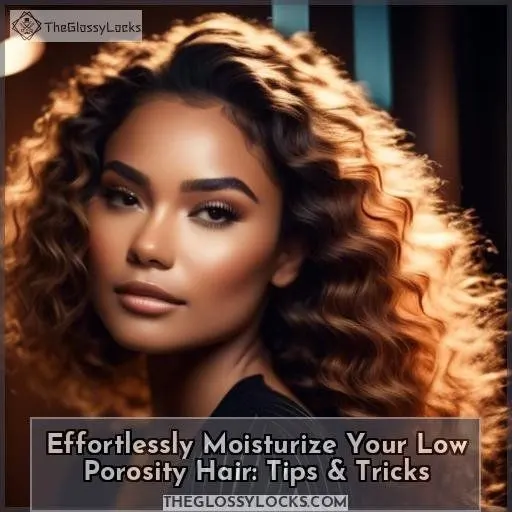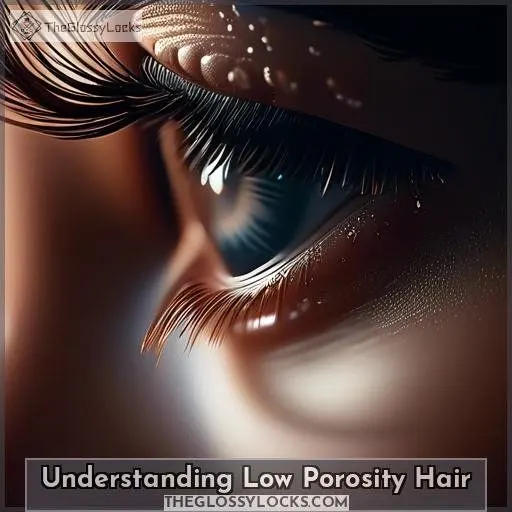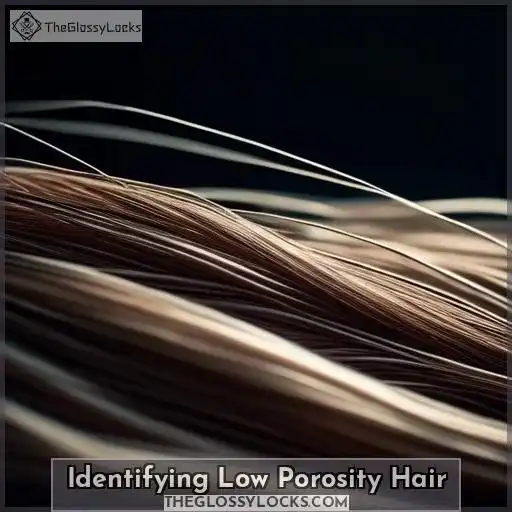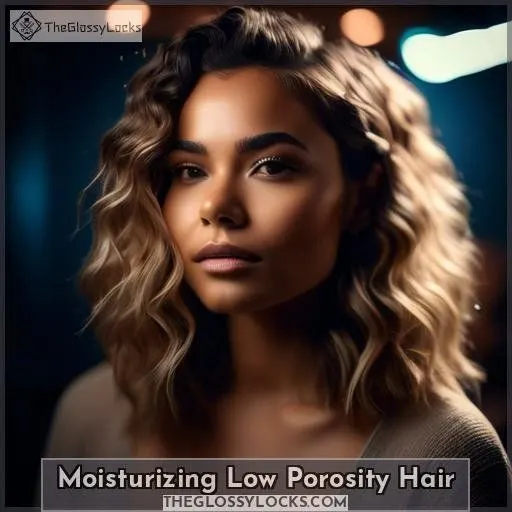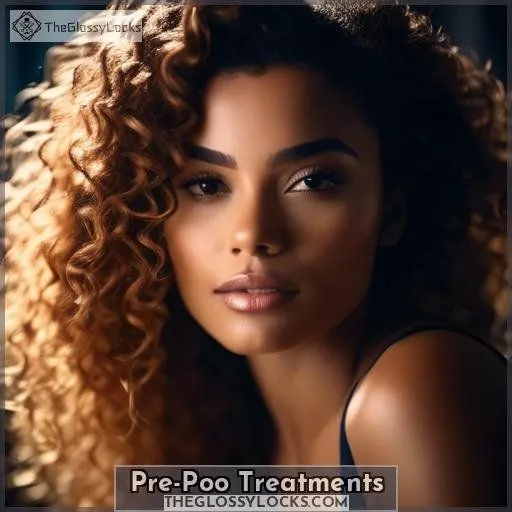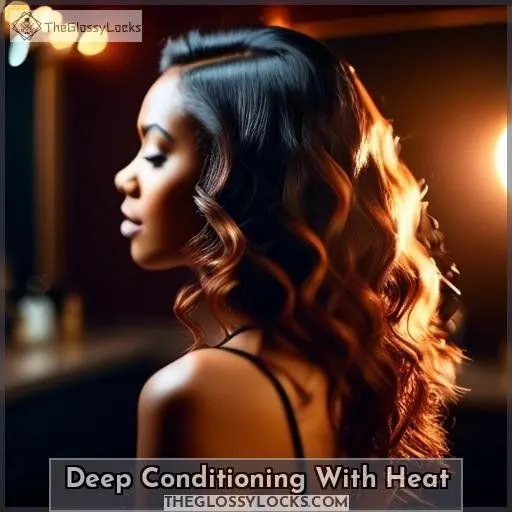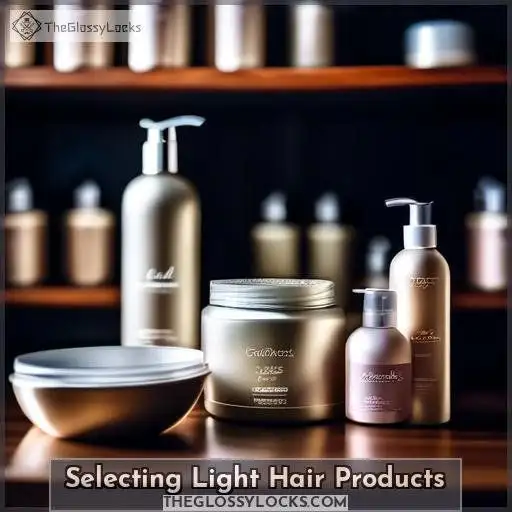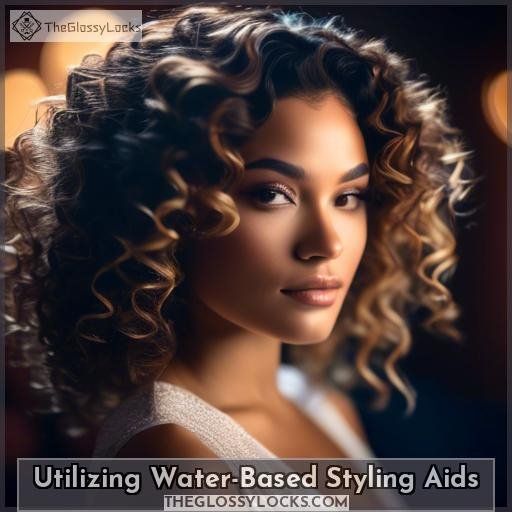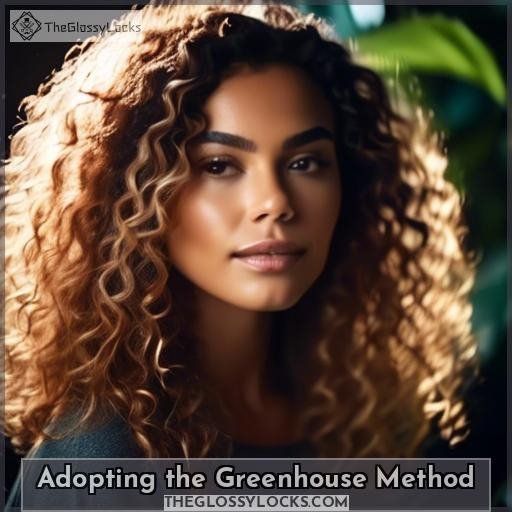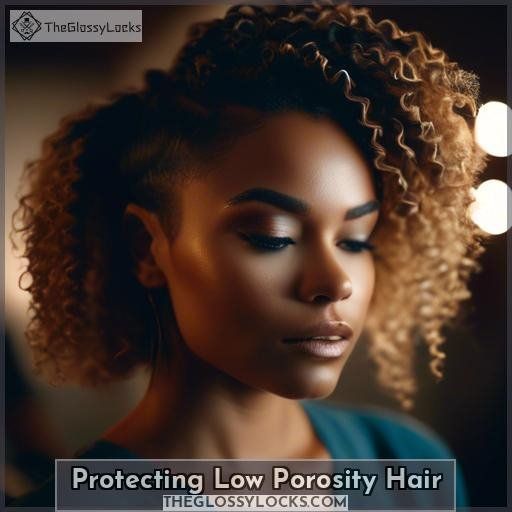This site is supported by our readers. We may earn a commission, at no cost to you, if you purchase through links.
To effortlessly moisturize your low porosity hair, start by using emollient and humectant-rich products that’ll smooth your tightly bound cuticles and draw moisture into the hair shaft. Apply these products with the help of heat, which’ll lift your cuticles for better absorption.
Don’t forget to clarify regularly to prevent product buildup, and deep condition weekly to maintain that essential moisture.
Consider pre-pooing before shampooing to protect your hair, and experiment with lighter, water-based styling aids that won’t weigh your hair down.
By following these tips, you’ll be well on your way to achieving the supple, healthy low porosity hair you desire. Keep reading to learn more advanced techniques.
Table Of Contents
- Key Takeaways
- How to Moisturize Low Porosity Hair?
- Understanding Low Porosity Hair
- Identifying Low Porosity Hair
- Moisturizing Low Porosity Hair
- Pre-Poo Treatments
- Deep Conditioning With Heat
- Selecting Light Hair Products
- Utilizing Water-Based Styling Aids
- Adopting the Greenhouse Method
- Protecting Low Porosity Hair
- Frequently Asked Questions (FAQs)
- Conclusion
Key Takeaways
- Utilize emollients and humectants in your hair care routine to smooth the hair cuticle and draw moisture into the hair shaft, respectively.
- Apply heat during your moisturizing process to lift the tightly bound cuticles of low-porosity hair, allowing for better absorption of products.
- Regularly clarify your hair to prevent product buildup, ensuring that moisture can effectively penetrate the hair shaft.
- Incorporate weekly deep conditioning into your hair care regimen to maintain essential moisture and prevent dryness.
How to Moisturize Low Porosity Hair?
To moisturize low porosity hair, use water-based moisturizers and light oils. Avoid heavy oils like coconut oil, castor oil, and olive oil. Instead, opt for lightweight oils such as apricot kernel oil, argan oil, grapeseed oil, and sweet almond oil.
Deep condition with heat, using indirect or direct heat methods. Clarify your hair regularly to remove product buildup. Apply a moisturizing hair mask once a week.
Use a water-based leave-in conditioner, followed by a lightweight oil to seal in moisture. Avoid heavy products that can build up on low porosity hair.
Keep your hair moisturized between washes by spritzing it with a water-based moisturizer or aloe vera spray and sealing with a light oil.
Understanding Low Porosity Hair
Understanding low porosity hair is essential for preserving its well-being. With tightly bound cuticle layers, low porosity hair resists moisture, making it moisture-averse. This can lead to dry, coarse hair that lacks suppleness and is vulnerable to split ends and product accumulation.
To care for low porosity hair, concentrate on using products that contain emollients and humectants, applying heat to raise the cuticle, clarifying frequently, and deep conditioning weekly. Remember, wash day is all about hydration, beginning with a pre-poo treatment, shampooing, conditioning, and deep conditioning.
Welcome the challenge of low porosity hair and learn to moisturize it seamlessly.
Identifying Low Porosity Hair
Do you know how to identify if you have low porosity hair? The float test, slip ‘n’ slide test, and shower test are easy ways to determine if your hair has a tightly packed cuticle layer that makes it resistant to moisture absorption.
Float Test
To identify low porosity hair, try the float test. Wet your hair and place it in a bowl of water. If your hair floats at the top for a while before sinking, it’s a sign of low porosity.
This type of hair is moisture-resistant and has tightly bound cuticles, making it harder for water to absorb.
To moisturize low porosity hair, use emollients and humectants, apply heat to lift the cuticle, and clarify regularly.
Slip ‘n’ Slide Test
Slip ‘n’ Slide Test: To identify low porosity hair, try the slippage test. Run your fingers along your hair shaft. If they glide smoothly, your hair has a tightly bound cuticle, which can hinder moisture absorption.
To moisturize low porosity hair, use products with emollients and humectants. Heat can help open the cuticle for better absorption.
Regular clarification and weekly deep conditioning are essential. Choose lightweight formulas and avoid heavy oils and butters.
Shower Test
After gliding through the Slip ‘n’ Slide Test, it’s time to turn up the heat with the Shower Test. Here’s how to gauge your hair’s thirst:
- Monitor shower duration—does your hair repel water like a duck’s back?
- Check if cooler temps leave your strands unbothered.
- Observe how quickly (or not) your hair dries.
Moisturizing Low Porosity Hair
Moisturizing low porosity hair requires a strategic approach. Use emollients and humectants to deeply hydrate your strands, and apply heat to lift the tightly-bound cuticles for better product absorption.
Emollients and Humectants
To moisturize your low porosity hair effectively, you need to understand the role of emollients and humectants in your hair care routine. Emollients are ingredients that smooth down the hair cuticle and lock in moisture, while humectants attract water molecules from the environment into your hair. Both are essential for maintaining the health and hydration of low porosity hair.
When choosing products for your hair care routine, look for those that contain natural emollients like coconut oil, castor oil, argan oil, and shea butter. These ingredients will help to soften your hair and give it a brilliant shine. For humectants, consider using natural options like glycerin, honey, lecithin, or panthenol (Pro Vitamin B5). These ingredients will help to attract and retain moisture in your hair, making it softer and more elastic.
Remember to use humectants in moderation, as they can pull too much moisture from the environment into your hair, causing it to swell and become frizzy. Be mindful of the weather conditions when using humectants, as they may not work as effectively in high humidity or low humidity environments.
Incorporating emollients and humectants into your hair care routine will help to maintain the balance needed for healthy, hydrated low porosity hair. By understanding their role and using them appropriately, you can achieve the desired moisture and shine for your hair type.
Heat to Lift Cuticle
To effectively moisturize low porosity hair, utilizing heat to raise the cuticle layer can be advantageous. This can be accomplished through heat deep conditioning or by applying heat protectant sprays during heat styling. Warm water can also aid in opening the hair cuticle, facilitating better product absorption.
Products such as TGIN’s Honey Miracle Hair Mask and Aussie’s Miracle Smooth Conditioner can be employed in conjunction with heat to augment the moisturizing process. Furthermore, utilizing a heat cap or a hooded dryer during deep conditioning can assist in guaranteeing that the hair cuticle is fully opened, permitting greater product penetration.
Bantu knots and two-strand twists can also be employed to manipulate the hair without causing harm, as they don’t necessitate heat.
Regular Clarification
To maintain the well-being of your low porosity hair and keep it hydrated, it’s imperative to cleanse your hair more frequently than normal. This step aids in removing accumulation from your hair and scalp, enabling your hair to absorb moisture more effectively. Here are some pointers to integrate into your hair care regimen:
- Steer clear of sulfates: Sulfates have the potential to rob your hair of its inherent oils, making it more challenging to retain moisture. To avoid this, select shampoos and conditioners that are free of sulfates.
- Employ a heat cap: When deep conditioning, utilize a heat cap to facilitate the opening of the cuticles and enhance moisture absorption.
- Give the greenhouse method a try: Apply a deep conditioner, encase your hair in a plastic bag, and allow it to remain for an extended period to trap moisture within your hair.
- Experiment with LOC or LCO: The LOC (Liquid, Oil, Cream) or LCO (Liquid, Cream, Oil) method can assist in sealing in moisture and preventing evaporation.
- Avoid heavy oils: While oils can aid in moisturizing your hair, heavy oils may not penetrate low porosity hair effectively. Opt for lightweight oils that can be readily absorbed, such as sunflower seed oil, grapeseed oil, jojoba oil, or argan oil.
Remember to cleanse your hair consistently, deep condition with the aid of heat, and utilize lightweight products to preserve the health of your low porosity hair.
Weekly Deep Conditioning
Weekly Deep Conditioning Routine for Low Porosity Hair
Weekly deep conditioning is essential for low porosity hair to maintain moisture and prevent product accumulation. Here’s a step-by-step guide to integrating deep conditioning into your hair regimen:
- Pre-poo treatment: Before shampooing, apply a light oil or a pre-shampoo treatment that penetrates the hair shaft. This step aids in preventing moisture loss and safeguards your hair from the harsh effects of shampooing.
- Shampoo: Use a gentle, sulfate-free shampoo that’s formulated for low porosity hair. This will aid in cleansing your hair without removing its natural oils.
- Condition: Apply a moisturizing conditioner that’s rich in humectants and lightweight oils. These ingredients will aid in attracting and retaining moisture in your hair.
- Deep condition: After rinsing out the conditioner, apply a deep conditioner that’s specifically formulated for low porosity hair. Cover your hair with a shower cap or heat cap and use a hair steamer or diffuser to apply heat. This will aid the deep conditioner in penetrating your hair shaft and providing extra hydration.
- Rinse and style: Rinse out the deep conditioner and style your hair as desired. You can use water-based styling products that are lightweight and won’t leave accumulation on your hair.
Remember to deep condition your low porosity hair at least once a week, and adjust the frequency based on your hair’s needs. This routine will aid you in maintaining healthy, moisturized hair and preventing product accumulation.
Pre-Poo Treatments
Before you even think of shampooing, give your low porosity hair a pre-poo treat. Think of pre-poo oils and conditioners as your hair’s best friends, offering a shield against the harsh stripping of moisture that can happen during cleansing.
The benefits? You’ll step out of the shower with strands that feel more like silk and less like straw. Aim for a pre-poo session as a regular part of your routine, and choose products that whisper sweet nothings to your locks without weighing them down.
Deep Conditioning With Heat
Deep conditioning with heat is a game-changer for low porosity hair. This process helps to open the hair cuticle, allowing moisture to penetrate deeper into the hair shaft. You can use a hooded dryer, microwave method, hot towel, or steam treatment to activate the heat. Always remember to use heat-resistant gloves to protect your hands.
By incorporating heat into your deep conditioning routine, you’ll notice a significant improvement in the moisture levels of your low porosity hair.
Selecting Light Hair Products
With regard to hydrating low porosity hair, it’s advisable to select lighter formulas that won’t burden your strands. Consider ingredients such as babassu, black seed oil, argan, or aloe vera, and avoid potent sulfates, heavy silicones, and dehydrating alcohols. Test the LOC (Liquid, Oil, Cream) or LCO (Liquid, Cream) method to discover the appropriate moisture balance for your hair.
Understanding Low Porosity Hair
Comprehend the permeability, outer layer structure, and hydration absorption of your hair for the best product choices based on its texture.
Moisturizing Low Porosity Hair
Moisturizing low porosity hair can be a challenge, but with the right products and techniques, you can keep your strands hydrated and healthy. Here are some tips to help you moisturize your low porosity hair effectively:
- Use leave-in conditioners: Invest in a lightweight, hydrating leave-in conditioner specifically formulated for low porosity hair. These products help create a barrier against environmental damage while adding softness and natural sheen to your hair.
- Experiment with the LOC or LCO method: The Liquid, Oil, Cream (LOC) or Liquid, Cream, Oil (LCO) method can help you effectively lock in moisture by layering lightweight products on your hair.
- Try steam treatments: Steam opens up the cuticles, allowing products to penetrate the hair shaft more deeply, providing deep hydration and improving elasticity and manageability.
- Opt for hydrating hair masks: Use a hair mask formulated for low porosity hair to give your strands an extra boost of moisture and nourishment.
- Perform scalp massages: Massaging your scalp can help stimulate blood flow and promote healthier hair growth, while also distributing natural oils from your scalp to the ends of your hair.
- Protect your hair: Wear a satin bonnet or use a silk or satin pillowcase to retain moisture and protect your hair from friction and damage.
- Deep condition weekly: Regular deep conditioning sessions can help replenish moisture and strengthen your hair over time.
babassu
Babassu oil, a lightweight champion, deeply moisturizes without weighing down your freedom-loving locks.
black seed oil
Black seed oil is a popular component in hair care products due to its potential advantages for hair growth and hydration. When considering using black seed oil for low porosity hair, here are three key points to keep in mind:
- Benefits: Black seed oil is renowned for its anti-inflammatory and antimicrobial qualities, which may aid in improving scalp health and fostering hair growth.
- Usage: Apply black seed oil to your scalp before shampooing as a pre-wash treatment to help prevent moisture loss. You can also combine it with a carrier oil such as jojoba or almond oil for easier application.
- Considerations: Be mindful of possible side effects, including nausea, vomiting, bloating, stomach pain, nasal dryness, and rash, which may occur with oral ingestion or topical application.
argan
Argan oil: A lightweight, nourishing choice for low porosity hair. Benefits include deep conditioning, pre-poo treatments, and leave-in use.
or aloe vera
Aloe vera is a popular ingredient in hair care, often recommended for its moisturizing properties. However, it may not be suitable for all hair types, especially low porosity hair. Here’s why:
- pH value: Aloe vera has a pH scale of 6, which is slightly acidic. Low porosity hair has cuticles that are always lowered and can only be lifted by warm moist heat and alkaline products. Aloe vera’s acidity shuts the cuticles and prevents them from receiving moisture. Instead of nourishment, the hair gets dried out because every other thing added after aloe vera application stays on the surface of the hair strands.
- Protein sensitivity: Aloe vera contains a compound similar to keratin (hair protein) in structure. This protein-like compound in the aloe vera gel when applied meets cuticles that are already healthy. It leaves low porosity hair brittle because the compound similar to keratin contained in aloe vera is too bulky for the cuticles to absorb.
Despite these potential drawbacks, aloe vera can still be beneficial for low porosity hair if used correctly. For example, aloe vera juice can be used as a film-forming humectant to help keep hair moisturized for longer periods of time, making it more pliable and preventing breakage. Aloe vera gel can also be used as a leave-in treatment to help seal moisture in low porosity hair.
Avoid strong sulfates
Regarding low porosity hair, it’s important to choose the appropriate hair products to preserve its well-being and hydration. One of the key aspects to take into account is the use of harsh sulfates, which can be damaging to hair and remove its natural oils, resulting in dryness and damage. Here’s an explanation of why harsh sulfates should be avoided in your hair care regimen for low porosity hair:
- Removal of Natural Oils: Harsh sulfates can strip your hair of its natural oils, which are essential for maintaining moisture and elasticity. Low porosity hair already has tightly bound cuticles, making it more prone to dryness. By avoiding harsh sulfates, you can help preserve the natural oils in your hair, keeping it hydrated and healthy.
- Damage and Breakage: The harshness of strong sulfates can lead to damage and breakage, especially in low porosity hair that’s more fragile due to its tightly bound cuticles. By avoiding harsh sulfates, you can help reduce the risk of damage and breakage, promoting healthier hair growth.
- Color Fading: Harsh sulfates can also cause color-treated hair to fade faster, as they remove color along with dirt and oil. If you have color-treated low porosity hair, it’s best to opt for sulfate-free hair products to preserve your hair color and maintain its vibrancy.
- Sensitive Scalp: If you have a sensitive scalp, harsh sulfates can cause irritation and redness. By avoiding harsh sulfates, you can help soothe your scalp and reduce the risk of irritation and discomfort.
heavy silicones
Heavy silicones can be a challenge for low porosity hair. These thick, butter-like substances, such as mineral oil and petroleum, can create a barrier that prevents moisture from penetrating the hair shaft. To avoid this issue, opt for lightweight products that can easily penetrate the hair, like water-soluble silicones, such as cyclomethicone and dimethicone copolyol.
Additionally, avoid using heavy silicones in your hair care routine, as they can lead to product buildup and weigh your hair down.
drying alcohols
Avoid drying alcohols for ideal porosity balance, improving ingredient absorption and product layering on your porosity scale.
Experiment with the LOC (Liquid
Experiment with the LOC method for low porosity hair, using lightweight oil sealants for heat protection and water retention. Layer moisture for maximum hydration.
Oil
Choose lightweight oils for better penetration and absorption without weighing down your hair.
Cream) or LCO (Liquid
To moisturize low porosity hair, try the LOC method with light products. Pre-poo treatments and the greenhouse method can also help. Water-based styling aids are key.
Cream
To effectively moisturize your low porosity hair, you’ll want to focus on using lightweight creams that can penetrate the tightly sealed cuticles and provide lasting hydration. Here are three creams that are perfect for your hair type:
- Controlled Chaos Curl Creme: This cream is specifically formulated for low porosity hair and is intended to promote moisture penetration, provide frizz control, and deliver a balanced combination of hydration and hold for beautifully defined curls.
- Rizos Curls Leave-In Conditioner: This conditioning yet lightweight leave-in contains natural ingredients like coconut oil, aloe vera, and shea butter, which work together to reduce frizz, deeply condition, and provide a deeply moisturizing effect without leaving your hair looking greasy.
- Sally Beauty Biotera Alcohol-Free Gel with Bamboo: This affordable gel is a great option for low porosity hair, as it’s lightweight and doesn’t leave a heavy residue on your strands. It can help manage frizz and provide hold without weighing down your hair.
Remember to use these creams as part of a well-rounded hair care routine that includes pre-poo treatments, heat deep conditioning, and regular clarification to maintain the health and moisture of your low porosity hair.
Utilizing Water-Based Styling Aids
Now that you’ve mastered the art of selecting light hair products, it’s time to explore the domain of water-based styling aids. These products are your secret weapons for keeping your low porosity hair moisturized and looking fabulous.
Water-based leave-ins, gels, mousses, creams, and sprays are your new best friends. They hydrate your hair without leaving buildup, which is a common issue with low porosity hair.
To help you navigate this new area, we’ve created a table featuring some popular water-based styling aids. Remember, experimentation is key, so don’t be afraid to try different products and find what works best for your hair.
| Product Type | Examples | Benefits |
|---|---|---|
| Water-based leave-in | Mielle Organics Leave-In Conditioner | Provides long-lasting hydration |
| Water-based gel | Cantu Shea Butter Moisturizing Curl Activator Cream | Defines curls and holds styles |
| Water-based mousse | DevaCurl Light Defining Cream | Adds volume and body |
| Water-based cream | Kinky-Curly Knot Today Curl Custard | Moisturizes and defines curls |
| Water-based spray | Ouidad Advanced Climate Control Heat & Humidity Gel | Protects hair from environmental damage |
Adopting the Greenhouse Method
Adopting the Greenhouse Method is a game-changer for moisturizing low porosity hair overnight. Here are three ways to get started:
- Moisturize with Humectants vs. Emollients: Humectants draw moisture from the air, while emollients seal in moisture. Combine both for maximum hydration.
- Heat Cap Benefits: Use a heat cap or hooded dryer to enhance the penetration of your chosen products. This allows deeper moisture absorption and reduces frizz.
- Steam Treatment Alternative: If a hooded dryer isn’t an option, try a steam treatment. It provides similar benefits, helping your hair retain moisture while you sleep.
Protecting Low Porosity Hair
Protect your low porosity hair by using satin bonnets and pillowcases, which help retain moisture and prevent breakage. Avoid excessive heat styling and regularly trim split ends to promote healthy hair growth.
Satin Bonnets and Pillowcases
Wrap your locks in satin bonnets or rest on silk pillowcases to champion moisture retention and reduced friction. This dynamic duo works wonders for overnight hydration, ensuring your hair health isn’t left to chance. It’s like a nightly spa for your strands!
Avoiding Heat Styling
Avoiding heat styling is fundamental for low porosity hair. Excessive heat can harm your hair, causing split ends and breakage. Choose air-drying or using heat-protective products. Blow drying and flat ironing should be avoided or minimized. By reducing heat exposure, you’ll safeguard your hair’s health and improve its natural radiance.
Trimming Split Ends
Essential step in preserving low porosity hair’s moisture is to address split ends. Here are three imperative points to observe:
- Systematically trim your hair to eliminate compromised ends.
- Employ a detangler with teeth widely spaced to avoid causing hair breakage while detangling.
- Apply a pre-shampoo treatment or intensive conditioner with warmth to intensify absorption and moisture retention.
Regular Deep Conditioning
Deep conditioning is essential for low porosity hair, as it helps the hair absorb moisture and nutrients more effectively. To deep condition low porosity hair, follow these steps:
- Pre-poo treatment: Apply a pre-poo treatment before shampooing to prevent moisture loss. Use products with penetrating oils like grapeseed oil, jojoba oil, or argan oil.
- Heat application: Use heat to open the hair cuticles and enhance absorption. Sit under a dryer for about 25 minutes, or use a heating cap or shower cap wrapped in a towel.
- Weekly routine: Deep condition your hair weekly to replenish moisture and strengthen the hair.
- Moisturizing products: Choose lightweight, water-based products that penetrate easily into the hair shafts. Avoid heavy oils and butters that can leave a residue.
- Avoid sulfates and silicones: Stay away from strong sulfates and heavy silicones, which can weigh down low porosity hair.
- Experiment with the LOC (Liquid-Oil-Cream) or LCO (Liquid-Cream-Oil) method: These methods help to seal in moisture and prevent product buildup.
Frequently Asked Questions (FAQs)
How often should I moisturize low porosity hair?
You’ll want to moisturize low porosity hair 2-3 times a week. This keeps your strands hydrated without weighing them down. Experiment to find the right frequency that leaves your hair feeling soft and supple.
What are the best products for moisturizing low porosity hair?
Ahh, the eternal quest to tame the mane of the recalcitrant low-porosity strands. Honey, you gotta treat those babies like the delicate flowers they’re – lightweight oils, water-based moisturizers, and a generous dose of patience.
How can I prevent product buildup on low porosity hair?
To prevent buildup, regularly clarify your low porosity locks. Use a gentle, sulfate-free shampoo and steer clear of heavy oils and creams. This’ll keep your hair hydrated without weighing it down or clogging your cuticles.
Should I use heat when moisturizing low porosity hair?
Using heat when moisturizing low porosity hair can help lift the tight cuticles, allowing moisture and products to better penetrate. Just be sure not to overdo it – a little goes a long way.
How can I protect low porosity hair from damage?
Wrap your precious locks in a satin embrace, shielding them from friction’s frazzle. Ditch heat’s harsh caress, and let your curls flourish freely, free from damage’s dreadful dance. Safeguard your strands, and set free their true splendor.
Conclusion
Well, when life gives you low porosity hair, make moisturizing lemonade! By mastering the art of how to moisturize low porosity hair, you’ll discover the secret to silky, healthy tresses.
Embrace your hair’s unique needs, and you’ll be rocking voluminous, moisturized locks in no time.

